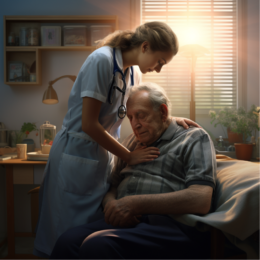What Causes Red Feet in Elderly: All You Need to Know

We thought you might like these too…
Moving Elderly Parents to Another State: A Comprehensive Guide
Effective Strategies for Dealing with Selfish Elderly Parents
3 Tips to Help You Choose Between Assisted Living Vs. In-Home Care
Understanding Caregiving Duties and Responsibilities
Incontinence Care: 9 Essential Tips for Caregivers
As we age, our bodies undergo numerous changes, some of which are visible, like the appearance of our skin. One such change that many elderly individuals notice is the reddening of their feet. But what causes red feet in elderly? Let’s dive deep into the reasons behind it.
The Aging Process and Skin Changes
Aging affects the skin in various ways. The skin becomes thinner, loses elasticity, and is more prone to dryness and bruising. As the skin’s protective barrier weakens, it becomes more susceptible to infections and other conditions, leading to redness and other discolorations.
Common Causes of Red Feet in the Elderly
Peripheral Arterial Disease (PAD)
PAD is a condition where plaque builds up in the arteries, reducing blood flow to the limbs. This can cause the feet to appear red or purplish and feel cold. Monitoring for PAD is essential as it can lead to more severe complications if left untreated.
Venous Insufficiency
This condition occurs when the veins in the legs can’t efficiently send blood back to the heart. It can cause swelling, pain, and redness in the feet and ankles.
Diabetes
In 2019, 37.3 million people, or 11.3% of the U.S. population, had diabetes. Diabetes can cause peripheral neuropathy, leading to red feet. It’s crucial for seniors with diabetes to regularly check their feet for any changes.
Skin Conditions and Infections
Our skin becomes more susceptible to various conditions and infections as we age. The thinning of the skin, combined with a weakened immune system, can make the elderly more prone to these issues.
Fungal Infections
Fungal infections, such as athlete’s foot or toenail fungus, thrive in warm, moist environments. Symptoms can include itching, burning, and redness. Elderly individuals, especially those with compromised immune systems or diabetes, are at a higher risk. Regular foot hygiene, including keeping feet dry and clean, can help prevent these infections.
Cellulitis
Cellulitis is a bacterial skin infection that can appear as a swollen, red area on the skin that feels tender and hot. It can spread rapidly and can be severe if not treated promptly. Elderly individuals with poor circulation or breaks in the skin are more susceptible. Immediate medical attention is crucial if cellulitis is suspected.
Medications and Side Effects
Medications are a double-edged sword. While they can be life-saving and improve the quality of life, they can also come with side effects, some of which can manifest on the skin.
Common Medications That May Cause Redness in the Feet
Several medications can lead to skin reactions, including redness in the feet. It’s essential to be aware of these potential side effects and consult a healthcare professional if any changes are noticed after starting a new medication.
Drug-Induced Skin Reactions and Their Impact on the Elderly
The elderly often take multiple medications, increasing the risk of drug interactions and adverse reactions. Some of these reactions can manifest as skin conditions, ranging from mild redness to severe rashes. Regular check-ups and medication reviews can help in early detection and management.
The Importance of Medication Review and Adjustment
The body’s metabolism changes with age, affecting how drugs are processed. Regular reviews of medications can ensure that they are still appropriate in dose and type. Adjustments can help prevent adverse reactions, including those that affect the skin.
Lifestyle Factors
Our daily habits and lifestyle choices play a significant role in our overall health, including the health of our feet.
Lack of Physical Activity and Its Effect on Circulation
Physical activity promotes good circulation, which is vital for skin health. A sedentary lifestyle can lead to poor circulation, contributing to redness in the feet. Incorporating regular physical activities for the elderly, even simple exercises like walking can make a difference.
Poorly Fitting Footwear and Its Impact on Foot Health
Shoes that don’t fit properly can cause a myriad of foot problems, from blisters to redness and swelling. Investing in good-quality, well-fitting shoes is essential to prevent such issues.
Dietary Habits and Their Connection to Red Feet
A balanced diet for seniors ensures they get the necessary nutrients for overall health. Dehydration, for instance, can affect skin health, leading to dryness and redness. Consuming a diet rich in vitamins and minerals and staying hydrated can help maintain healthy skin.

Smoking and Its Effect on Peripheral Circulation
Smoking narrows the blood vessels, reducing blood flow to the extremities. This can result in redness and other foot problems. Quitting smoking can improve circulation and reduce the risk of related complications.
Quick Poll
When to Seek Medical Attention
If the redness in the feet is accompanied by pain, swelling, or other symptoms, seeking medical attention is essential. Early diagnosis and treatment can prevent complications.
Preventive Measures
Regular foot care, maintaining a healthy lifestyle, and monitoring for any changes can help prevent red feet in the elderly.
Treatment Options
Treatment options vary based on the cause of the redness. They might include medications, lifestyle changes, or other interventions.
Mr. Thompson’s Unexpected Journey with Red Fee
Mr. Thompson, a spry 72-year-old, always prided himself on being active and health-conscious. However, one morning, as he was lacing up his sneakers for his daily walk, he noticed a distinct redness on his feet, which he initially dismissed due to his new socks. Days turned into weeks, and the redness persisted, occasionally accompanied by a mild tingling sensation. Concerned, he recalled a recent change in his medication and wondered if that could be the culprit.
His curiosity led him to consult his doctor, who confirmed that the new medication might be causing the redness. The doctor adjusted his prescription, and the redness faded within weeks. Relieved, Mr. Thompson realized the importance of being vigilant about even the smallest changes in his body. He now shares his story with friends and family, emphasizing the significance of listening to one’s body and seeking medical advice when in doubt.
Conclusion
Red feet in the elderly can be caused by various factors, from medical conditions to lifestyle choices. It’s essential to be aware of the causes and seek treatment when necessary. Remember, our feet carry us throughout our lives; let’s ensure they remain healthy!
INSPIRED BY MRS. THOMPSON, WHO NOTICED REDNESS IN HER FEET AFTER STARTING A NEW MEDICATION, HAVE YOU EVER EXPERIENCED A SIMILAR SITUATION? SHARE YOUR EXPERIENCES, AND LET’S LEARN FROM EACH OTHER!





